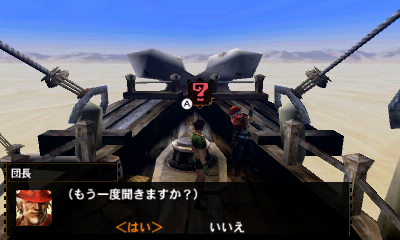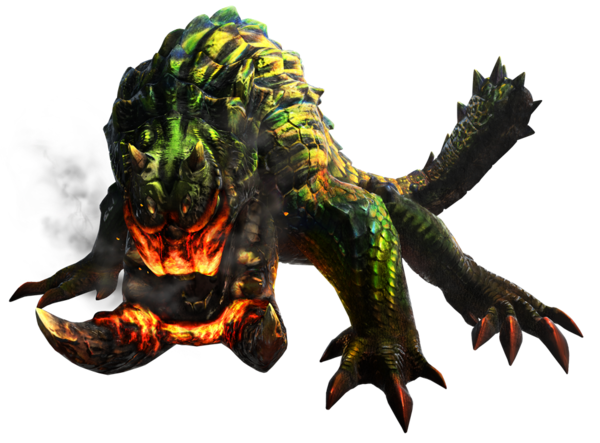
Monster Hunter 4 Ultimate: Localization & The Ultimate Question!
Jan 13, 2015 // Andrew Alfonso
With a game that’s as complex as Monster Hunter, learning the ropes requires a lot of patience and a guiding hand. The Monster Hunter community is one of most dedicated groups of players around, and, from personal experience, nobody ever hesitates to give out advice or mentor first-timers through the early stages of the game.
In Monster Hunter 4 Ultimate, the early tutorials that teach you the basics of the game are abundant and cover everything from the basic controls to cooking meat and delivering items. It’s all done while you’re on specific quests, and they are definitely helpful when you don’t know a Nitroshroom from a Scatternut. But there was something we had an issue with…

If you can’t read Japanese, this message translates to “Do you want to hear that again?”, and automatically appears after every tutorial message. The cursor also defaults to Yes, so if you’re mashing buttons to get through the tutorial, you can accidentally select Yes and you’re sent through the entire thing again.
This was one of the first issues I brought to the Monster Hunter team, because I felt Western gamers wouldn’t respond well to it. After the director, Fujioka-san, explained their reasoning, I understood why they had made this decision. During the development of Monster Hunter 4, the team was directed to aim for a younger audience because the Nintendo 3DS’ market is younger than other platforms. To make sure the younger kids knew what do to, they added that question at the end of each tutorial just to be safe.
Overseas, the audience for Monster Hunter is older and more experienced with games, so they typically don’t need to read things twice to get the gist. With that in mind, we asked the team if we could remove that from our version of the game and they agreed. Woohoo! Victory #1! We also were able to naturally cut down on the tutorial length through shorter, but still entertaining dialogue – and no, we didn’t cut out anything from the tutorials – which means you can get back to the action a lot faster.
This is just one of the many subtle ways that we tweaked Monster Hunter 4 Ultimate for its Western release to make it more enjoyable to play. I’ll go into detail about other things we did in future posts!
For now, let’s talk about monsters and Harth, the second village you’ll visit in Monster Hunter 4 Ultimate !
The Troverian Town
When you first arrive in Harth, it’s a depressing run-down place, but that’s because the Troverian inhabitants have a ton of monster-related problems, and it’s your job as a hunter to solve them! Help them get back on their feet and the village will revert back to its bustling, fiery self!

In the Japanese version, the village was called Naguri, which roughly translates to “ striking things ”, in this case with a forging hammer. When we localized the title we had to go with a slightly different idea because I don’t think anyone wants to visit a place called Village of Hammering Bros . Or maybe you do, who knows? Anyway, well-read people (or Blizzard fans) probably got this right away, but the name Harth is based on a traditional forging hearth, so we stuck with the original Japanese concept, but made it more intuitive for most non-Japanese speaking gamers.
Tetsucabra

One of the first monsters you’ll face after you arrive in Harth is Tetsucabra, a gigantic toad-like beast with massive tusks. Not only can it dig up and toss giant boulders at you, it also has a spit attack that drains all of your stamina, leaving you helpless as it bulldozes right through you. The naming process for Tetsucabra was a bit longer than we had anticipated. The monster’s Japanese name alludes to iron (hence “ tetsu ”), and character traits such as stubborn and demonic, so we aimed for a stubborn, tough-sounding name, and came up with Cabrado and Testaran. The former was based on a combination of obstinado (Spanish for stubborn) and an attempt to keep the cabura (ã‹ã¶ã‚‰) part of the Japanese name, which is a type of ogre-like tile found on Japanese rooftops. Testaran was conceived by combining testardo (Italian for stubborn, bullheaded) and Ranidae, the scientific family name for true frogs.

Cabura is a type of Onigawara, classic tiles found in Japanese architecture. There are ones that resemble demons too!
When we ran these names by Fujioka-san, he rejected both of them and asked for a couple of new proposals. The names themselves weren’t bad at all, he said, but Tetsucabra (and its subspecies) was designed with some Japanese overtones. Believe it or not, many of Tetsucabra’s attacks are based on sumo techniques, such as the sidestomp, which mimics a traditional shikogeri (四股蹴り), and his kanji name (鬼蛒) was created to appear more Japanese in nature. Knowing this information really helped, and we decided that if the monster was designed to be more Japanese, we ought to stick with the Japanese name for MH4U.
Berserk Tetsucabra
The subspecies name was a lot trickier to come up with because of the information we got from the team. The kanji name changed to depict a “crazy demon frog” (è’鬼蛒), and when we talked with Fujioka-san, he wanted a Japanese-sounding name based on the term aragoto (è’事). This word has its roots in theatrical kabuki, and is a type of role the actors play. Aragoto style refers to a very wild, exaggerated acting style that focuses on loud, bold words and actions. The kabuki actors who assume this role often wear white makeup with striking red patterns, which you can even see in the Berserk Tetsucabra’s face when he gets angry. (Incidentally, the opposite of aragoto is wagoto (和事), a supporting role with a softer, gentler tone.)
 (Example of Kabuki aragoto and its counterpart, wagoto.)
(Example of Kabuki aragoto and its counterpart, wagoto.)
The Gauntlet of Fujioka was thrown down, and we had to come up with something that was going to get this whole aragoto business through to the player. But how? In Western plays there aren’t many suitable words to describe this idea, and we had to make it sound Japanese, too.
We decided to come up with two different takes on the name. One was Chambara Tetsucabra, a term that’s associated with the samurai cinema genre in English. It’s not a widely used term for sure, but we thought enough people would know about it to make it work. We thought this was a bit of a mouthful to say, but having both words end with similar sounds would make it easier to remember – and it also sounds cool.
The other name was Magmacabra, which isn’t based on aragoto, but on the attacks the monster utilizes. The subspecies digs up and tosses molten boulders instead of plain ol’ rocks, so we thought it’d be a good fit. Yeah, it didn’t match with the aragoto theme, but it was consistent with how we normally name our subspecies by basing it on color or characteristics.

Fujioka-san didn’t like either name, as Chambara sounded a little too weird, and Magmacabra broke convention with other subspecies names, because we usually have a prefix and the monster name, not a merging of the two, so we made a hasty retreat to Castle Brainstorm! This challenge proved to be a bit too much for us, unfortunately, so we came back to Fujioka-san with just one more proposal. Instead of something Japanese sounding, we proposed Berserk Tetsucabra. It still conjures up an image of a wild, swing-for-the-fences type of monster and is also easy to understand. Given the options we threw out there, Fujioka-san agreed that Berserk was the best-sounding name out of the bunch and we went ahead with that.
Ruby Basarios
Ruby Basarios was an odd case for us because it highlighted just how different the meaning of words can be, particularly if they’re used in different cultures. We came up with a short list of possible names for Basarios’ subspecies, including Coral, Azalea and Ruby. Obviously, we loved the last one because it truly represented what this monster was – a colorful and rock-solid beast. However, Fujioka-san and lead designer Tokuda-san didn’t agree with our assessment. They thought the word Ruby sounded too cute instead of sounding hard and solid. We had to talk about this for a good half hour, but eventually we won them over thanks to the combined might of my laptop and Wikipedia!

Well, that’s it for now. Thanks for reading! I’ll have another article ready next week, where I’ll talk about a dangerous couple and one of the new weapons in Monster Hunter 4 Ultimate !
-
Brands:Tags:
-

Loading...
Platforms:
